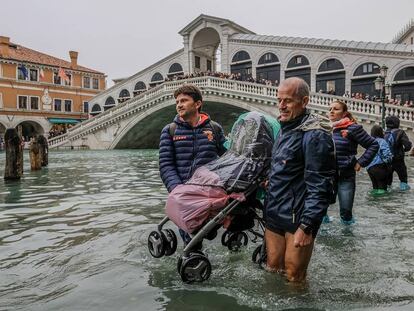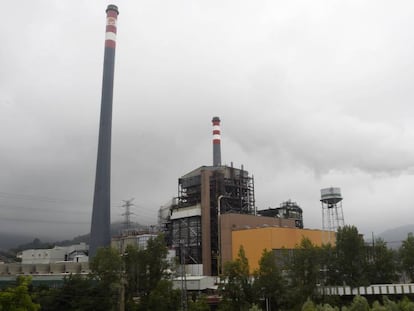More than a feeling: summers in Spain really are getting longer and hotter
A new study shows the impact of global warming on temperatures, the sea level and human health in the country


It’s more than a feeling: there are figures to back it up. Climate change has come to Spain, and its effects are mainly noticeable in the higher temperatures. The summer season now lasts almost five weeks longer on average than it used to in the early 1980s. And it is also hotter.
These are some of the conclusions of a new joint report from the national weather agency AEMET and the Ministry for Ecological Transition. Both institutions have offered data from the Open Data Climático project, which collects evidence of the impact of global warming on Spain in the last 40 years.
An increasingly warm Mediterranean has an impact on coastal regions, with a rise in tropical nights
Beatriz Hervella, AEMET
According to the ministry, more than 32 million Spanish people are affected by global warming. Beatriz Hervella, an AEMET spokesperson, said that these people live in parts of Spain where the summers are now longer and hotter.
There has been an accumulation of very warm years in the last decade, and an increase in so-called “tropical nights,” or nights with a minimum temperature of 20ºC.
Minister Teresa Ribera underscored the cause of climate change: the greenhouse gas emissions cause by human activity. She also noted that the International Energy Agency has warned that emissions of CO2 – the main greenhouse gas – by the energy and industrial sectors reached a new record in 2018.
Earlier heatwaves
The rising temperatures also mean that the first heatwaves of the year are coming earlier and catching us by surprise, says Julio Díaz of the National School of Public Health, which is part of the Carlos III Health Institute. “It’s not the same having one in May as it is in August.”
These higher temperatures are also bad for cardiovascular and respiratory diseases, especially in older people. This expert on public health and the environment says the heat also increases visits to the doctor by people with kidney problems and those with neurodegenerative diseases such as Parkinson’s. It likewise causes a rise in premature babies and low weight at birth.
The heat is also linked to approximately 1,200 deaths a year in Spain, a number that could soar to 12,000 by the end of the century if something is not done, warns Díaz. “It all depends on how we adapt.”
His study group has analyzed the effect of rising temperatures on the combined rate of morbidity and mortality, and observed that for every extra degree there was a 14% rise in 1983, but only a 2% or 3% rise in 2013, which shows that humans are adapting, or adopting “what the Americans call the heat culture”: a set of measures ranging from more air conditioning units to more green areas in cities and prevention plans for at-risk groups.
The AEMET report also highlights that in Spain, the surface area with a semi-arid climate has increased in the last 50 years by 30,000 km2 – similar in size to the entire region of Galicia. The most affected areas are the region of Castilla-La Mancha, the Ebro valley and southeastern Spain. These are areas with classic or continental Mediterranean climates that have turned into semi-arid places with less rainfall, according to Rubén del Campo, another AEMET spokesperson.
The analysis is based on data collected by 58 observatories, 52 of which are located in or near provincial capitals and in the exclave cities of Ceuta and Melilla in North Africa. Six more were added because of the particular historical relevance of their data sets.
The analysis found that for at least five years since 2011, 37 observatories registered “average annual temperatures within the hottest 20% in the reference period.” The most extreme example was the Barcelona-Airport observatory, where every year since 2011 has been very hot.
As for the four seasons, their average temperatures are higher, although “the rise is more noticeable in the spring, and especially in the summer.” Summers in Spain are also getting longer and hotter, says the report. The study found that “the summer season now lasts five weeks more than it did in the early 1980s.”
The summer season, which AEMET defines solely by the temperatures, now starts earlier. According to the Madrid-Retiro weather station, in the 1970s the summer used to begin on July 15 and end on September 16. These days, it starts on June 11 and ends on September 22.
Mediterranean Sea
The report also analyzed the temperature of surface water in the Mediterranean, and concluded that it has been rising by 0.34ºC every decade since the early 1980s. This in turn is causing the sea level to rise. Since 1993, the global sea level has been rising 3.4mm a year.
“An increasingly warm Mediterranean has an impact on coastal regions, with a rise in tropical nights,” said Hervella. These hotter nights make it difficult to sleep, which in turn “has an impact on health.” A clear example of this is Alicante, she said, although inland cities such as Madrid can also experience tropical nights because of the “heat island effect” created by buildings that trap warmth.
English version by Susana Urra.
Tu suscripción se está usando en otro dispositivo
¿Quieres añadir otro usuario a tu suscripción?
Si continúas leyendo en este dispositivo, no se podrá leer en el otro.
FlechaTu suscripción se está usando en otro dispositivo y solo puedes acceder a EL PAÍS desde un dispositivo a la vez.
Si quieres compartir tu cuenta, cambia tu suscripción a la modalidad Premium, así podrás añadir otro usuario. Cada uno accederá con su propia cuenta de email, lo que os permitirá personalizar vuestra experiencia en EL PAÍS.
¿Tienes una suscripción de empresa? Accede aquí para contratar más cuentas.
En el caso de no saber quién está usando tu cuenta, te recomendamos cambiar tu contraseña aquí.
Si decides continuar compartiendo tu cuenta, este mensaje se mostrará en tu dispositivo y en el de la otra persona que está usando tu cuenta de forma indefinida, afectando a tu experiencia de lectura. Puedes consultar aquí los términos y condiciones de la suscripción digital.
More information
Archived In
Últimas noticias
Mexico seeks to shore up its defenses following US incursion in Venezuela
Hope gives way to uncertainty among Venezuelan exiles in the US after Maduro’s capture
Cubans look to Venezuela fearfully after Trump’s incursion: ‘We could be next’
The operation in Venezuela to capture Maduro threatens to widen the cracks in the MAGA movement
Most viewed
- Alain Aspect, Nobel laureate in physics: ‘Einstein was so smart that he would have had to recognize quantum entanglement’
- Gilles Lipovetsky: ‘If you want to live better and fall in love, take Prozac, don’t look to philosophy’
- Alvin Hellerstein, a 92-year-old judge appointed by Bill Clinton, to preside over Maduro’s trial in New York
- Cuba confirms death of 32 of its citizens in the US attack against Venezuela
- Why oil has been at the center of Venezuela-US conflicts for decades










































